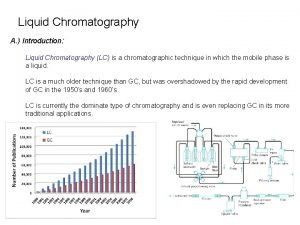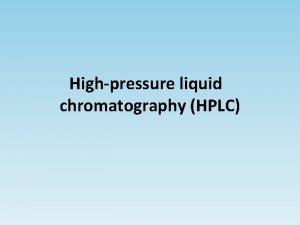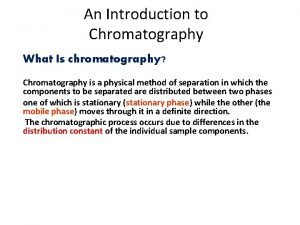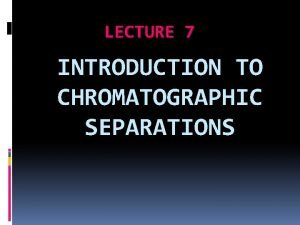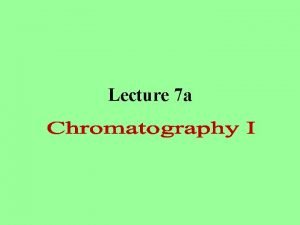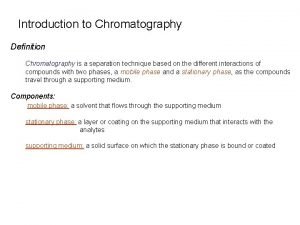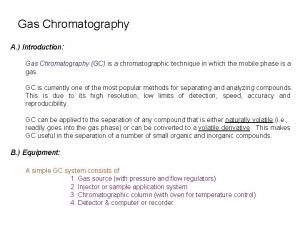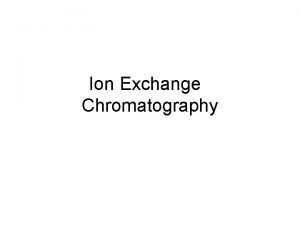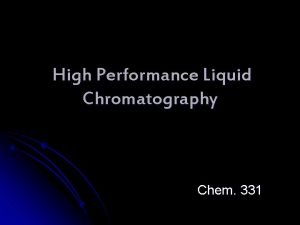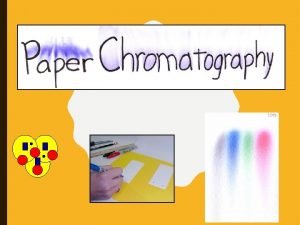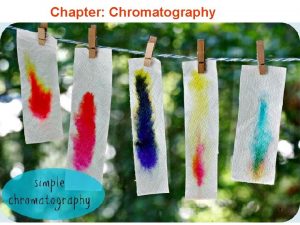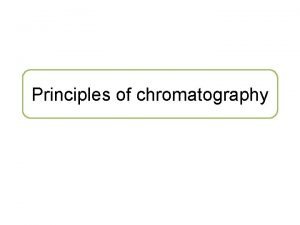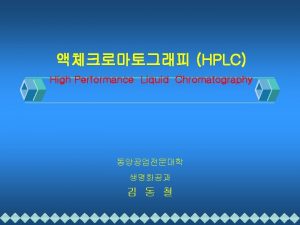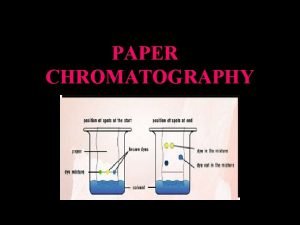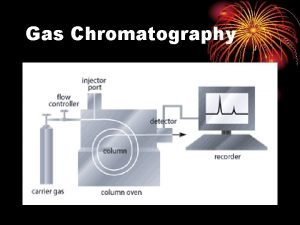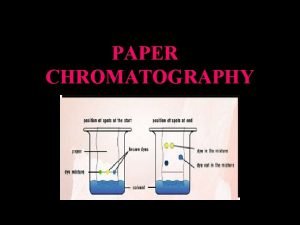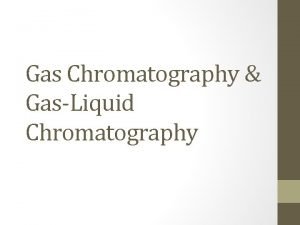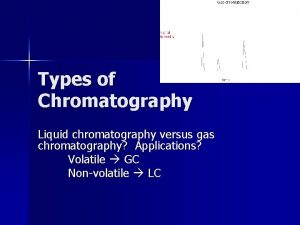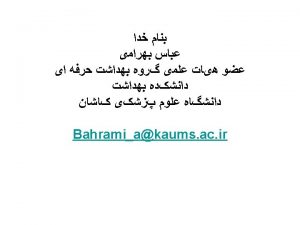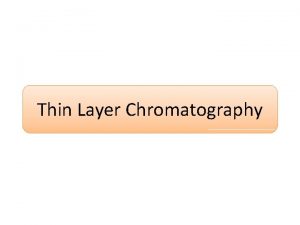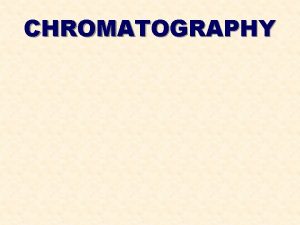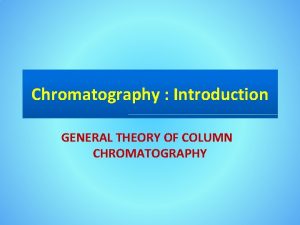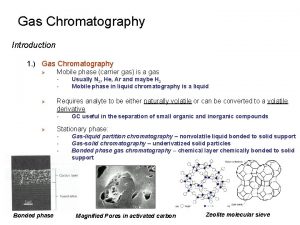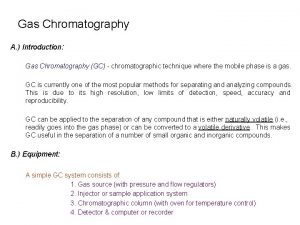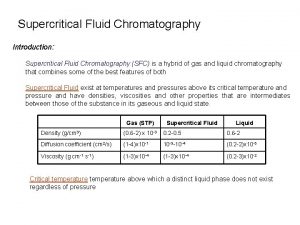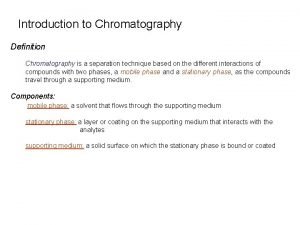An Introduction to Chromatography What IS chromatography The





















































- Slides: 53

An Introduction to Chromatography • What IS chromatography? • The separation of a mixture by distribution of its components between a mobile and stationary phase over time – mobile phase = solvent – stationary phase = column packing material

Chromatography Detector Signal Chromatogram - Detector signal vs. retention time or volume 1 2 time or volume

Milestones in Chromatography • 1903 Tswett - plant pigments separated on chalk columns • 1931 Lederer & Kuhn - LC of carotenoids • 1938 TLC and ion exchange • 1950 reverse phase LC • 1954 Martin & Synge (Nobel Prize) • 1959 Gel permeation • 1965 instrumental LC (Waters)

Purpose of Chromatography • Analytical - determine chemical composition of a sample • Preparative - purify and collect one or more components of a sample

Classification of Methods • There are two classification schemes: – mobile phase – attractive forces

Mobile Phase • • gas (GC) water (LC) organic solvent (LC) supercritical fluid (SCFC)

Classification based on Mobile Phase Gas Chromatography Gas - solid Gas - liquid Pyrolysis GC heat solid materials to 500 - 10000 C so they decompose into gaseous products Stationary Phase Sample MUST be volatile at temperatures BELOW 3500 C

Classification based on Mobile Phase Liquid chromatography (LC) Column (gravity flow) High performance (pressure flow) Thin layer (adsorption)

Classification based on Attractive Forces • Adsorption - for polar non-ionic compounds • Ion Exchange - for ionic compounds – Anion - analyte is anion; bonded phase has positive charge – Cation – analyte is cation; bonded phase has negative charge • Partition - based on the relative solubility of analyte in mobile and stationary phases – Normal – analyte is nonpolar organic; stationary phase MORE polar than the mobile phase – Reverse – analyte is polar organic; stationary phase LESS polar than the mobile phase • Size Exclusion - stationary phase is a porous matrix; sieving

Detectors • • UV-vis Refractive Index (RI) Mass spectrometry (MS) Electrochemical (EC) – amperometric • NMR - novel

Problem: • What would be a good method for determining the following: – identity of accelerant at a suspected arson scene – amount of caffeine in Coca Cola – identifying active ingredient in an illicit drug preparation (LSD is heat sensitive) – purification and characterization of novel thermophilic plant enzyme from South America – identifying explosive materials used in Oklahoma bombing

The GC-MS Process

GC-MS Analysis of Money Courtesy of Agilent.

Food Chemistry • Size Exclusion Chromatography to assess olive oil quality (authenticity, storage) – SEC - mode of separation – Detection • RI • UV (254 nm) Dauwe, C. ; Reinhold, G. ; Okogeri, O. Am. Lab. 2001, Dec. , 22, 24.

Evaluate • Resolution – selectivity ( tr) – efficiency (w) • Recovery – mass recovery – activity recovery • Capacity • Practicality (Robustness)

Instrumentation Analytical Chemistry Lecture #2

Basis of Chromatography • Definition: Cs = C m K • Mechanism - selective retardation caused by interactions with bonded phase of stationary phase

Definitions • Mobile phase - phase that moves through chromatograph – In GC - carrier gas is the mobile phase • Stationary phase - column; phase that is stationary in chromatograph • Bonded phase - reactive groups imparted to stationary phase in order to achieve selectivity

Types of Chromatography • Classification by mobile phase: – Gas - Gas chromatography (GC) • 1951 Martin and James (fatty acids) – Liquid - Liquid chromatography (LC) • 1964 Horvath (Yale) instrument • 1966 Horvath and Lipsky (nucleic acid components) – Supercritical fluid - Supercritical fluid chromatography (SFC) • 1958 Lovelock (Yale)

Instrumentation for GC • Carrier gas – N 2, He, H 2 • • Injector Column Detector Computer oven

Modes of GC Separation • Capillary (open tubular) – Inner wall modified with thin (1 m) film of liquid – 0. 3 - 0. 5 mm ID; 10 - 50 m length • Packed – Solid particles either porous or non-porous coated with thin (1 m) film of liquid – 1 - 8 mm ID; 1 - 10 m length

GC Liquid Phase • • Low volatility High bp Chemically unreactive Examples: – 1 -squalene – Tetrahydroxyethylenediamine – Carbowax (polyethylene glycol)

GC - Modes of Separation • Isothermal (GC) • Programmed temperature (GC) – Raising column temperature (GC) • Decreases retention time • Sharpens peaks

Properties of a Good Detector • High sensitivity - Response/ Conc’n • Universal or selective response – selectivity - ability to distinguish between species • Rapid response • Linearity - concentration range over which signal proportional to concentration • Stability with respect to noise (baseline noise) and time (drift)

Detectors for GC • Electron capture (ECD) – radioactive – good for X-, NO 2 - and conjugated • Thermal conductivity (TCD) – change in resistance of heated wire • Flame ionization (FID) – destruction of combustible sample in flame produces measurable current • Fourier transform infrared (FTIR) • Mass spectrometry (MS)

MS Components • Ionization source • Analyzer • Detector

Ionization Methods • Electron capture (EC) – 70 e. V e- neutral molecule energetic molecular ion – hard; fragmentation • Chemical ionization (CI) – Reagent ion + molecule molecular ion + reagent ion – Reagent ion = He, OH- (water), CH 5+ or CH 3+ (CH 4)

Ionization Methods • Electrospray (ESI) – generation of ions by desolvation or desorption of charged liquid droplets • Matrix Assisted Laser Desorption (MALDI) – ionization facilitated by laser irradiation of sample dissolved in an organic matrix – EX: sinapinic acid

Types of MS Analyzers • Quadrupole - most common • Ion trap • Time of Flight (TOF)

Two Operational Modes • Scan – Collect mass data over known range – Slow • Selective ion monitoring (SIM) – Sample mass at predetermined values – Fast

Total Ion Chromatogram tr Detector Response time of injection Retention Time

Mass Spectrum - GC-MS • x-axis – GC-MS - m/z – LC - retention time or volume • y-axis - detector response – GC-MS - % abundance – LC - Abs

Analysis of Organic Mass Spectral Data Analytical Chemistry Lecture Topic #3

Mass Spectrum • X - axis: m/z • mass - based on 12 C 12. 0000 • Y - axis: relative abundance – usually normalized wrt largest line (base peak) – 0 - 100 %

Major Steps in Analysis of Mass Spectral Data • Identification of molecular ion – Base peak • Examination of isotopic distribution pattern – Negative information – Determine elemental composition • Analysis of fragmentation pattern – Propose possible structures – Compare postulated species to available reference spectra

Molecular Ion • Ion whose mass equals that calculated from the molecular formula using the masses for each element which have the highest natural abundance; often tallest peak in highest m/z group • Base peak - most intense peak in spectrum; not necessarily the molecular ion peak!

Example: Mass Spectrum of Methanol (CH 3 OH) CH 3 OH + e- CH 3 OH+ + 2 e. CH 3 OH + CH 2 OH+ + H CH 3 OH + CH 3+ + OH CH 2 OH + H 2 + CHO+

Example 2: Mass spectra for cyclophosphamide • Method of sample ionization may also change molecular ion – EI: M + – CI: MH+ Figure taken from Rubinson, K. A. Chemical Analysis Boston: Little, Brown, 1987.

Lessons: • Single charge most common so m/z usually equates to mass (EI/CI) • Ions may fragment – EX: CH 3 OH loses H+ readily – Observe: CH 3 O +

Isotopes • Most abundant isotope of an element is set to 100% • Abundance of other isotopes are normalized with respect to it

3 Classes of Isotopes • A - only a single isotope – EX: F, P, I • A+1 - two isotopes with significant relative abundance differing by 1 mass unit – EX: H, C, N • A+2 - two isotopes with significant relative abundance differing by 2 mass units – EX: Cl, O, S

Natural Isotopic Abundance of Common Elements in Organic Compounds A

Natural Isotopic Abundance of Common Elements in Organic Compounds A+1 A+2

Isotopic Distribution Patterns • If Cl- present then two peaks with ratio 100: 32. 5

Question: • What Will the Mass Spectrum of Cl 2 Look Like? (Relative Abundance and m/z for all species)

Cl 2 Revisited • Two isotopes: 35 Cl and 37 Cl • Three possible species formed: and 37 Cl • Relative abundance: 35 Cl, 37 Cl 35 Cl, – 35 Cl: – – 1. 0 x 1. 0 = 1. 0 37 Cl 35 Cl and 35 Cl 37 Cl: 1. 0 x 0. 325 = 0. 325 each or 0. 66 37 Cl: 0. 325 x 0. 325 = 0. 106 • So, answer: 3 peaks at 70, 72, and 74 with relative intensities of 100, 32. 5, and 10. 6 %

Natural Isotopic Abundance of Common Elements in Organic Compounds A+2

Problem 1:

Step 1: Identify Molecular Ion ? ?

Step 2: Normalize Intensity with Respect to the Molecular Ion Q: Does pattern look familiar? A +2

Step 3: Identify Possible Species • 84 - 2*(35) = 14 • Remaining species must be A-type (C, H, etc) • 14 - 12 = 2 • Suggests: 2 H, 1 C, and 2 Cl CH 2 Cl 2

Step 3: Identify Possible Species (cont’d) Q: Does pattern look familiar? A+2

Step 3: Identify Possible Species • 49 - (35) = 14 • Remaining species must be A-type (C, H, etc. ) • 14 - 12 = 2 • Suggests: 2 H, 1 C, and 1 Cl CH 2 Cl+
 Disadvantages of liquid chromatography
Disadvantages of liquid chromatography Principles of hplc
Principles of hplc Chromatography introduction
Chromatography introduction Introduction of chromatography
Introduction of chromatography Chromatography was discovered by
Chromatography was discovered by Introduction of chromatography
Introduction of chromatography Introduction of gas chromatography
Introduction of gas chromatography Introduction of chromatography
Introduction of chromatography Ion exchange chromatography introduction
Ion exchange chromatography introduction High performance liquid chromatography introduction
High performance liquid chromatography introduction Hát kết hợp bộ gõ cơ thể
Hát kết hợp bộ gõ cơ thể Slidetodoc
Slidetodoc Bổ thể
Bổ thể Tỉ lệ cơ thể trẻ em
Tỉ lệ cơ thể trẻ em Chó sói
Chó sói Thang điểm glasgow
Thang điểm glasgow Hát lên người ơi alleluia
Hát lên người ơi alleluia Các môn thể thao bắt đầu bằng tiếng chạy
Các môn thể thao bắt đầu bằng tiếng chạy Thế nào là hệ số cao nhất
Thế nào là hệ số cao nhất Các châu lục và đại dương trên thế giới
Các châu lục và đại dương trên thế giới Công thức tính độ biến thiên đông lượng
Công thức tính độ biến thiên đông lượng Trời xanh đây là của chúng ta thể thơ
Trời xanh đây là của chúng ta thể thơ Mật thư anh em như thể tay chân
Mật thư anh em như thể tay chân Làm thế nào để 102-1=99
Làm thế nào để 102-1=99 Phản ứng thế ankan
Phản ứng thế ankan Các châu lục và đại dương trên thế giới
Các châu lục và đại dương trên thế giới Thể thơ truyền thống
Thể thơ truyền thống Quá trình desamine hóa có thể tạo ra
Quá trình desamine hóa có thể tạo ra Một số thể thơ truyền thống
Một số thể thơ truyền thống Cái miệng xinh xinh thế chỉ nói điều hay thôi
Cái miệng xinh xinh thế chỉ nói điều hay thôi Vẽ hình chiếu vuông góc của vật thể sau
Vẽ hình chiếu vuông góc của vật thể sau Thế nào là sự mỏi cơ
Thế nào là sự mỏi cơ đặc điểm cơ thể của người tối cổ
đặc điểm cơ thể của người tối cổ Thế nào là giọng cùng tên? *
Thế nào là giọng cùng tên? * Vẽ hình chiếu đứng bằng cạnh của vật thể
Vẽ hình chiếu đứng bằng cạnh của vật thể Tia chieu sa te
Tia chieu sa te Thẻ vin
Thẻ vin đại từ thay thế
đại từ thay thế điện thế nghỉ
điện thế nghỉ Tư thế ngồi viết
Tư thế ngồi viết Diễn thế sinh thái là
Diễn thế sinh thái là Dạng đột biến một nhiễm là
Dạng đột biến một nhiễm là Bảng số nguyên tố
Bảng số nguyên tố Tư thế ngồi viết
Tư thế ngồi viết Lời thề hippocrates
Lời thề hippocrates Thiếu nhi thế giới liên hoan
Thiếu nhi thế giới liên hoan ưu thế lai là gì
ưu thế lai là gì Sự nuôi và dạy con của hổ
Sự nuôi và dạy con của hổ Sự nuôi và dạy con của hươu
Sự nuôi và dạy con của hươu Sơ đồ cơ thể người
Sơ đồ cơ thể người Từ ngữ thể hiện lòng nhân hậu
Từ ngữ thể hiện lòng nhân hậu Thế nào là mạng điện lắp đặt kiểu nổi
Thế nào là mạng điện lắp đặt kiểu nổi Body paragraph structure
Body paragraph structure Chromatography uses
Chromatography uses
